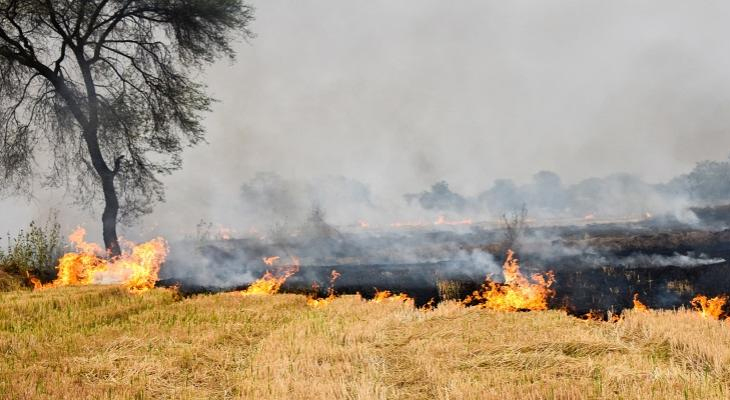
Stubble Burning Farmers: Architects of Delhi’s Breathing Woes, or Hapless Scapegoats?
Published 15 November 2019 by Abhinav Choudhry under Sustainable Development

From being a topic that only schoolchildren used to care about while writing essays, to capturing national headlines on a regular basis, air pollution in India has come a long way. The Air Quality Index (AQI) is now being tracked as keenly as major stock market indices like the BSE Sensex. This winter in Delhi, AQI levels reached 999, over sixteen times the recommended level of 60; schools were once again shut down, and everyone in Delhi took their own measures to minimize external exposure to the noxious smoke. The newfound awareness of the media is welcome, but they have once again jumped the gun by blaming Delhi’s winter pollution woes on the very visible practice of stubble burning by farmers close to India’s National Capital Region. This is faulty for two reasons. Firstly, stubble burning is only responsible for a fraction of the overall pollution and it occurs for less than a month. Secondly, it is less a matter of environmentally unfriendly farmers and more a matter of government inaction. This utterly predictable annual phenomenon is not really manageable at the farmer level as the infrastructure to take care of paddy residue does not exist as of now. On a positive note, this does seem to be changing.
Farmers in the state of Punjab (and to a lesser extent Haryana) grow a disproportionate share of India’s cereals. There are many policy reasons for this including electricity pricing policy and the government’s minimum support price scheme that favours cereals. This means that rice paddy farmers dominate Punjab’s agriculture and they also grow wheat in the winter months. The time window between harvesting of the paddy crop and planting of the wheat crop is just 10 to 20 days in late October–November. Delay in sowing would risk compromising on the yield of the wheat crop while planting the paddy crop earlier would entail suboptimal utilization of monsoon rains, and consequently greater reliance on scarce groundwater. Therefore, the farmer cannot lengthen this time window and has to speedily dispose of the residue leftover by the combined harvesters prior to sowing the wheat crop. Burning has been the traditional go-to option for farmers in India; it is easy and costless unlike alternative means of disposal. While the agricultural residue could serve as a great fuel source for biomass power plants, these power plants are very expensive to set up and are few and small in capacity; they are currently capable of utilizing less than 5% of the 20 million tonnes of paddy residue generated annually (Gupta 2019). Baling is also not a very farmer-friendly practice since transportation costs are high and the open market price of bails of paddy residue is too low to be economically feasible.
Fortunately, there are solutions and among them, a viable, affordable and scalable technological solution has become particularly attractive in the past several years. An innovative machine called the Happy Seeder which cuts and lifts the rice straw and then leaves it as mulch over the field even as it plants the wheat seeds. Generally, it even increases yields (Sidhu et al. 2015) and profitability is higher compared to other disposal alternatives. These alternatives include other machines and the traditional practice of residue burning (Shyamsundar et al. 2019). It is estimated that 35,000 Happy Seeders would be enough to cover the entire crop area responsible (Gupta 2019). In spite of these advantages, the uptake has been rather limited. Barriers to the adoption of Happy Seeders include high upfront cost of purchase, high and variable cost of rental, and lack of farmer awareness. The number of Happy Seeders manufactured was also unable to keep pace with increasing sales. These problems are finally being addressed: a substantial government subsidy is available for purchase, the state government is actively promoting Happy Seeders, and manufacturing facilities are being expanded. Thousands of Happy Seeders are now expected to join the agricultural workforce each year. Even biomass power plants may receive game changing fresh investment to produce thousands of megawatts of electricity (IANS 2019). Farmer support for them had already been picking up with some farmers even paying for the baling process and cost of transportation thus bearing the double whammy of cost and convenience (Krar 2018).
Not all farmers could be expected to altruistically bear the costs of residue disposal. Many also mistakenly believe that burnt residue contains soil nutrients. Given that the cost of moving to alternatives is non-zero, and that traditional practices are entrenched, the threat of legal enforcement may be needed as a motivating factor. Yet, it is insensitive to do that at present, when farmers realistically have no immediate alternative. This is justifiably making them angry (Khanna 2019). The Supreme Court’s directive of providing farmers Rs. 100 ($1.5) per quintal of residue is insufficient for proper disposal. Nevertheless, it does seem that a combination of Happy Seeders and biomass power plants would solve the stubble burning problem in the next several years, at least in Punjab. The lessons learnt do need to be implemented actively in India because many kinds of stubble are burnt regularly across the agricultural landscape.
Agricultural waste burning is not benign, not in India, and not elsewhere. Brazil, for example, suffers from the health consequences of post-harvest sugarcane fields set on fire (Rangel and Vogl 2016). Still, its contribution has to be understood in context; a study found that the burning of all the agricultural wastes of the San Francisco Bay Area of one year would still emit less pollution than one day of traffic in the same area (Darley et al. 2012). The Bay Area has far lesser vehicles than the National Capital Region of India. So, while residue burning could account for a significant portion of Delhi’s pollution on certain days (Gandhiok 2018), the primary problems lie elsewhere. Instead of Delhi’s reactive strategy of undertaking emergency short-term measures on pollution only after it crosses unbearable thresholds, there is a need for a predictive strategy as followed successfully in Beijing. However, the major difference would be made by longer term measures. There need to be hard decisions taken around construction activity, brick kilns, power plants, industries, and pollution norms. Though individual awareness is on the rise, it needs to rise much further: burning is still a common way of disposing garbage; burning twigs, leaves (and worse) for heat is common, even in polluted urban centres.
It does seem rather incredulous that directives around air pollution, whether they concern the quality of firecrackers around the festival of Diwali, or the disposal of rice stubble, are always passed after the moment of timely action has already passed. The latest emergency move has been that of halting all construction activity. This is definitely not a sustainable move. Even if the relatively easy measure of ensuring that construction sites are covered had been taken earlier, there would already have been major public health improvements. Hopefully, the experience will serve as a valuable lesson, not just for Delhi but other cities in India and elsewhere in the developing world. Development is inherently unsustainable and utterly meaningless when it comes at the cost of health.
References
Darley, E F, F R Burleson, E H Mateer, J T Middleton, and V P Osterli. 2012. “Journal of the Air Pollution Control Association Contribution of Burning of Agricultural Wastes to Photochemical Air Pollution.” https://doi.org/10.1080/00022470.1966.10468533.
Gandhiok, Jasjeev. 2018. “Pollution Level in Delhi: Farm Fires Contribute 33% to Delhi’s PM2.5 | Delhi News - Times of India.” Times of India. 2018. https://timesofindia.indiatimes.com/city/delhi/farm-fires-contribute-33-to-delhis-pm2-5/articleshow/66517337.cms.
Gupta, Niti. 2019. “Paddy Residue Burning in Punjab Understanding Farmers ’ Perspectives and Rural Air Pollution.” CEEW, no. March.
IANS. 2019. “NRI Offers Help in Generating Power from Stubble in Punjab.” 2019. https://m.economictimes.com/small-biz/productline/power-generation/nri-offers-help-in-generating-power-from-stubble-in-punjab/articleshow/71967252.cms.
Khanna, Rajeev. 2019. “Farmers in Punjab Are Burning Stubble as an Act of Rebellion.” Downtoearth.Org. 2019. https://www.downtoearth.org.in/news/agriculture/farmers-in-punjab-are-burning-stubble-as-an-act-of-rebellion-67669.
Krar, Parshant. 2018. “Paddy Stubble Catalyses Employment, Business in Punjab, Haryana - The Economic Times.” ET Bureau. 2018. https://m.economictimes.com/news/economy/agriculture/paddy-stubble-catalyses-employment-business-in-punjab-haryana/articleshow/66774434.cms.
Rangel, Marcos A, and Tom Vogl. 2016. “Agricultural {Fires} and {Infant} {Health}.” National Bureau of Economic Research Working Paper Series No. 22955. https://doi.org/10.3386/w22955.
Shyamsundar, P., N. P. Springer, H. Tallis, S. Polasky, M. L. Jat, H. S. Sidhu, P. P. Krishnapriya, et al. 2019. “Fields on Fire: Alternatives to Crop Residue Burning in India.” Science 365 (6453): 536–38. https://doi.org/10.1126/science.aaw4085.
Sidhu, H. S., Manpreet Singh, Yadvinder Singh, J. Blackwell, Shiv Kumar Lohan, E. Humphreys, M. L. Jat, Vicky Singh, and Sarbjeet Singh. 2015. “Development and Evaluation of the Turbo Happy Seeder for Sowing Wheat into Heavy Rice Residues in NW India.” Field Crops Research 184 (July): 201–12. https://doi.org/10.1016/j.fcr.2015.07.025

Abhinav Choudhry
Interested in private equity and research in sustainable finance. Domain expertise in financial services, sustainable agriculture and renewables. Masters in Public Administration from Cornell University has given me a specialization in Environmental Finance and Impact Investing which when added to his Masters in Finance from Delhi University, equivalent to MBA Finance, and Bachelors in Computer Science Engineering imbue him with a host of technical and soft skills. He have over four years of experience in banking and personal trading experience and professional certifications from the National Stock Exchange India.
He specialize in developing integrated solutions that utilize multiple stakeholders and cross-domain expertise by being able to mix a top-down approach with the ability to get technical in a specific area (He did this for biotechnology most recently) depending on the needs of the project.
Recent Articles
- India's March for Sustainable Future
- Water Insecurity in India
- A New Paradigm in the Financing of Solar Energy Projects
- Land Management: A step towards mitigating Land Degradation
- Impact of COVID-19 on Water Issues and the Way Forward
- Humanity better off with world order without ‘Chinese characteristics’
- Models to Make Vocational Training Work in India
- Will Seed Bill 2019 deliver the goods?
- Stubble Burning Farmers: Architects of Delhi’s Breathing Woes, or Hapless Scapegoats?
- Does India Need More Policy Action for Its Senior Citizens?
- Creating a future-proof curriculum for the digital age
- Policymakers, wake up! Floods in Chennai are not Alarm bells, they are explosions
- 'Environmental Finance — Private Capital and Private Profits for Public Gain— Pretty Promising, though not without Pain'
- Inclusive Innovations in Education Praxis
- Antibiotic Resistance: Fighting a Multi-Headed Demon
